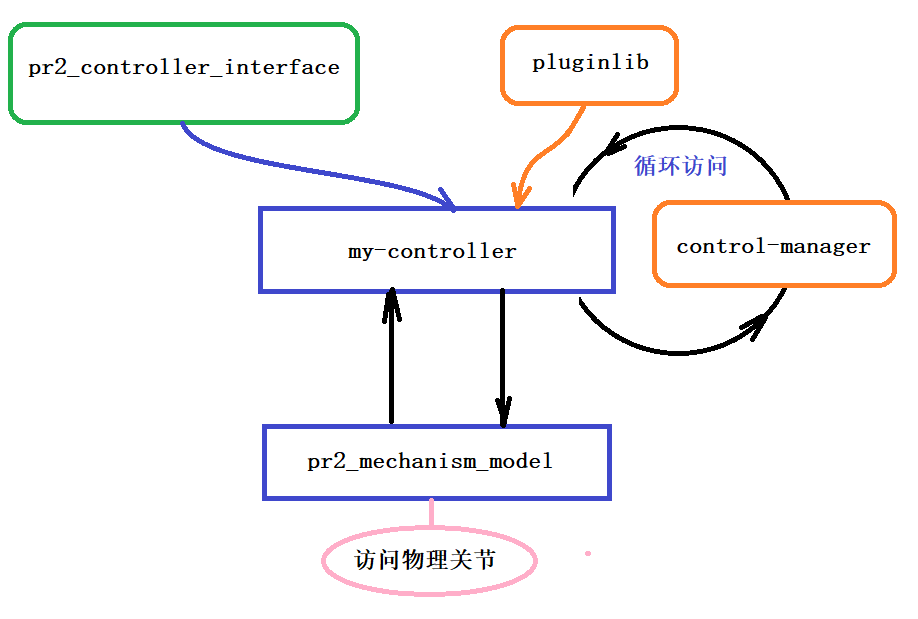目录
一、提要
二、结构介绍
三、定制ROS程序包
四、代码编写
五、代码的原理
六、编译代码
七、注册你的控制插件
一、提要
ROS中controller是个关键的概念群,掌握起来需要一大片时间;本教程教你如何编写一个可以在实时循环中执行的关节空间控制器。在阅读本文之前,最好是先看作者前面的文章做为预备知识: ROS-Control专题:PR2的六个概念【01】
二、结构介绍
要理解本教程和后续教程,您应该熟悉:
- pr2_controller_interface:它提供了代码接口,即你的代码将如何被调用。
- pr2_mechanism_model:尤其是 JointState,它提供对关节位置传感器和关节扭矩命令的访问。
- pr2_controller_manager:它加载/启动/停止并通常管理实时代码的执行。
三、定制ROS程序包

First, let's create a package where you'll build your controller. The package needs to depend on the pr2_controller_interface, the pr2_mechanism_model and the pluginlib. The controller interface package contains the base class for all controllers, the pr2_mechanism_model provides access to the robot joints, and the pluginlib package allows us to add our own controller as a plugin into the controller manager
(1)首先,让我们创建一个包,您将在其中构建您的控制器。
(2)该软件包需要依赖:
- pr2_controller_interface
- pr2_mechanism_model
- pluginlib。
(3)控制器接口包包含所有控制器的基类,pr2_mechanism_model 提供对机器人关节的访问,pluginlib 包允许我们将自己的控制器作为插件添加到控制器管理器中。
$ roscd ros_pkg_tutorials
$ roscreate-pkg my_controller_pkg pr2_controller_interface pr2_mechanism_model pluginlib
$ roscd my_controller_pkg
让我们已经构建了新包的所有依赖项:
$ rosmake四、代码编写
现在,在我们的新包中,创建目录 include,然后是 include/my_controller_pkg,启动编辑器,创建一个名为 include/my_controller_pkg/my_controller_file.h 的文件并将以下代码复制粘贴到该文件中:
#include <pr2_controller_interface/controller.h>
#include <pr2_mechanism_model/joint.h>
namespace my_controller_ns{
class MyControllerClass: public pr2_controller_interface::Controller
{
private:
pr2_mechanism_model::JointState* joint_state_;
double init_pos_;
public:
virtual bool init(pr2_mechanism_model::RobotState *robot,
ros::NodeHandle &n);
virtual void starting();
virtual void update();
virtual void stopping();
};
} 并创建一个目录 src 和一个名为 src/my_controller_file.cpp 的文件。将以下代码复制粘贴到此文件中:
#include "my_controller_pkg/my_controller_file.h"
#include <pluginlib/class_list_macros.h>
namespace my_controller_ns {
/// Controller initialization in non-realtime
bool MyControllerClass::init(pr2_mechanism_model::RobotState *robot,
ros::NodeHandle &n)
{
std::string joint_name;
if (!n.getParam("joint_name", joint_name))
{
ROS_ERROR("No joint given in namespace: '%s')",
n.getNamespace().c_str());
return false;
}
joint_state_ = robot->getJointState(joint_name);
if (!joint_state_)
{
ROS_ERROR("MyController could not find joint named '%s'",
joint_name.c_str());
return false;
}
return true;
}
/// Controller startup in realtime
void MyControllerClass::starting()
{
init_pos_ = joint_state_->position_;
}
/// Controller update loop in realtime
void MyControllerClass::update()
{
double desired_pos = init_pos_ + 15 * sin(ros::Time::now().toSec());
double current_pos = joint_state_->position_;
joint_state_->commanded_effort_ = -10 * (current_pos - desired_pos);
}
/// Controller stopping in realtime
void MyControllerClass::stopping()
{}
} // namespace
五、代码的原理
my_controller_ns是自己创建的一个realtime-controller类,我们通过继承controller::Controller基础类,构建自己的类;基类controller::Controller在pr2_controller_interface包中;通过函数超载,实现自己的功能,这些功能是Mechanism-Control在检查到状态变化后调用;四个函数必须超载:
1)init() 2)starting 3)update 4)stopping()
- 加载控制器时,将非实时调用 init 方法。
- 当控制器启动时,starting 将被实时调用一次,就在第一次调用更新之前。
- 当控制器运行时,实时循环会定期(1000 Hz)调用更新。
- 当控制器停止时,停止实时调用一次,就在最后一次更新调用之后。
有关基类中方法的详细说明,请查看pr2_controller_interface package documentation. (包文档)。
通过传递给 init 方法的 RobotState 对象提供对关节的访问。您应该使用 getJointState 方法在您的 init 方法中查找(按名称)您想要的关节。然后,您可以读取和写入返回的 JointState。有关如何访问信号/信息的详细信息,另请参阅 pr2_mechanism_model ( 包文档)。
六、编译代码
现在我们创建了代码,让我们先编译它。打开 CMakeLists.txt 文件,并在底部添加以下行:
rosbuild_add_library(my_controller_lib src/my_controller_file.cpp)进入你的包目录:
$ make如果一切顺利,您的 lib 文件夹中应该有一个名为 (lib)my_controller_lib.so 的库文件。
七、注册你的控制插件

现在编译为库的代码需要在实时进程中运行。这种链接可以以两种方式发生:(a) 自动,当实时过程开始时。当该过程开始时,它将搜索并加载您的库。或者 (b) 在进程运行时手动进行。您可以明确要求该过程动态加载您的库。然而,对于这两种情况,都需要将代码指定为用于实时进程,即需要将其注册为插件。然后 pr2_controller_manager 可以使用插件库来管理控制器的链接、加载和启动。
为了使控制器对 pr2_controller_manager、pluginlib 和实时进程可见,包含控制器的包必须将其导出为可加载类。首先要做的是从 src/my_controller_file.cpp 文件中调用插件注册宏。将以下行添加到该文件的底部:
/// Register controller to pluginlib
PLUGINLIB_DECLARE_CLASS(my_controller_pkg,MyControllerPlugin,
my_controller_ns::MyControllerClass,
pr2_controller_interface::Controller)再次重新编译:
$ make
接下来,要导出控制器,您还必须依赖 pr2_controller_interface 和 pluginlib 包,并在导出部分引用插件描述文件。在第 2 节的包创建过程中自动记录了依赖关系,但您需要在 <package> <package> 范围内将以下导出语句显式添加到 manifest.xml:
<export>
<pr2_controller_interface plugin="${prefix}/controller_plugins.xml" />
</export>所有的manifest.xml 看起来像:
<package>
...
<depend package="pr2_controller_interface" />
<depend package="pluginlib" />
...
<export>
<pr2_controller_interface plugin="${prefix}/controller_plugins.xml" />
</export>
...
</package>最后,您需要创建插件描述文件,清单中称为 controller_plugins.xml。该格式在插件库文档中进行了描述。对于我们的控制器,我们需要在 controller_plugins.xml 中进行以下描述:
<library path="lib/libmy_controller_lib">
<class name="my_controller_pkg/MyControllerPlugin"
type="my_controller_ns::MyControllerClass"
base_class_type="pr2_controller_interface::Controller" />
</library>现在,让我们确保控制器已正确配置为插件并且对 Mechanism Control 可见。检查插件描述文件是否对 rospack 可见:
$ rospack plugins --attrib=plugin pr2_controller_interface您本地的 controller_plugins.xml 文件应该在此列表中。如果不是,那么您可能没有添加 pr2_controller_interface 作为包的依赖项。
现在您已准备好学习下一个教程,如何 to run your controller.
最后
以上就是怕黑宝马最近收集整理的关于ROS-Control专题:写一个实时关节控制器( realtime joint controller)一、提要二、结构介绍三、定制ROS程序包四、代码编写五、代码的原理七、注册你的控制插件的全部内容,更多相关ROS-Control专题:写一个实时关节控制器(内容请搜索靠谱客的其他文章。








发表评论 取消回复